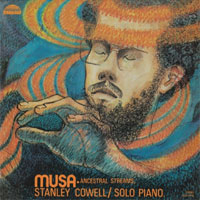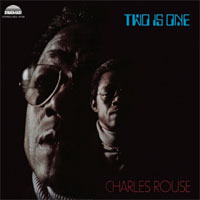Stanley Cowell • Musa Ancestral Streams Strata-East/Pure Pleasure SES-19743
Charles Rouse • Two is One Strata-East/Pure Pleasure SES-19746
o you like music that defies expectations? Stated another way, do you enjoy having your preconceptions contradicted and learning something new about an artist in the process? If so, these two reissues from UK-based Pure Pleasure offer up all of that -- in spades. Charles Rouse is the same Charlie Rouse known as the tenor saxophonist on most of Thelonious Monk’s 1960s recordings. His hard-bop roots were also on display as a sideman on many celebrated recordings, including sessions led by Donald Byrd, Clifford Brown, and Sonny Clark. He recorded a handful of releases as a leader, with Yeah! well known to audiophiles for its accomplished sound and straight-ahead jazz. Here, however, he embraced a more formal first name and tried his hand at funk’s decidedly less formal style. Funk was very much on the rise in 1974 when Strata-East recorded this session. Its heavy, danceable groove had been around since the 1960s, when James Brown created the signature style, but it broke large on the pop scene with Sly and the Family Stone’s late-1960s synthesis of funk and psychedelia. Miles Davis had been listening closely to Sly and Jimi Hendrix, and he combined the funk he heard them play with ambient music for his 1969 classic In a Silent Way. Playing with a band of mostly session musicians, Rouse builds slowly on side one, nodding more than once to In a Silent Way. The pianoless band is composed of two guitars, electric cello (played by Calo Scott who invented cello as a jazz instrument), two basses (with Stanley Clarke on loan from Return to Forever), drums, congas and percussion (Airto Moreira). In addition to tenor saxophone, Rouse plays bass clarinet on one song. After mostly slow burners on side one, largely inspired by Miles Davis, side two shifts gears and takes on a Pharoah Sanders groove -- at once more hard driving but soulful and spiritual. Calo Scott’s cello solo on “Two Is One” is worth the price of admission, and for “In His Presence Searching,” Rouse brings on the full spiritual-jazz confluence of bells and chimes, along with a turn on bass clarinet. Bill Robertson and Craig “Brewster” Bishop recorded the session in 1974 at The Warehouse in New York City. The sound is well balanced and tonally accurate, if lacking a sense of texture and color saturation that the best studios produced at the time. Stanley Cowell is one of the undersung heroes of jazz. Co-founder of cult label Strata-East, he performed in a wide variety of styles. In addition to being a sought-after sideman, he had regular projects that ranged from the quartet Music Inc to the Piano Choir (yes, a “choir” of eight keyboards). He would wow live audiences with solo performances of Art Tatum pieces. On the other hand, he could challenge his audience simply by naming a 1969 album Blues for the Viet Cong. That said, you might not expect a Stanley Cowell record to have much in common with the funk and out-of-the-box themes of the Rouse LP, but the title Ancestral Streams and the spacey cover art suggest otherwise. What the two albums share is the incorporation of the spiritual-jazz elements running through so much music in the 1970s. Cowell's quotation of the A Love Supreme riff in “Abscretions” is a giveaway. The second composition’s title, “Equipoise” (balance of forces), strengthens that conclusion. The third song, “Prayer for Peace,” leaves no room for doubt that Cowell is embracing the spiritual idiom. The album contains nine of Cowell’s finest compositions, and they make you think and feel in place of passive entertainment. There is nothing ambient about this music, and you will not confuse it with your Peter Kater or Steven Halpern space-age CDs. Cowell’s interest in jazz was ignited by family friend Art Tatum, but he also received a graduate degree in classical piano from the University of Michigan. His compositional skills are on full display here. Sure, he is a jazz pianist, but what this music evokes are those avant-garde LPs released back in the 1960s by Deutsche Grammophon or the equally challenging 1970s LPs on Nonesuch from Marc Aubort and Joanna Nickcrenz. The music is full of surprises, exploding with ideas, stunning and soothing at the same time. Cowell plays piano solo, except for the song “Travelin’ Man,” where he accompanies himself, overdubbing electric piano with an African thumb-piano track. The session was recorded in December 1973 at Ronn Carran’s now-defunct Minot Studios in White Plains, New Jersey, by John Battiloro and Carran. It is a close-in recording and a bit hot on top. Both LPs were remastered by Ray Staff at Air Mastering and pressed at Pallas in Germany. Both were flat and quiet, and that alone is something rarely encountered with originals from the 1970s. Both original records are rare, and you are not likely to come across a copy flipping through the bins at your local emporium. Both have been reissued in Japan and Holland, but those have long since vanished from shelves. Like most Strata-East releases, neither of these records
is for everyone. But for those whose interests extend beyond the boundaries of the
classics from Blue Note and the more progressive music from Impulse!, these are
exceptional records worth exploring. |


